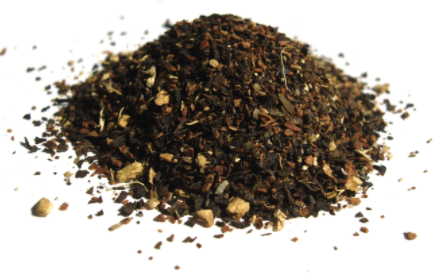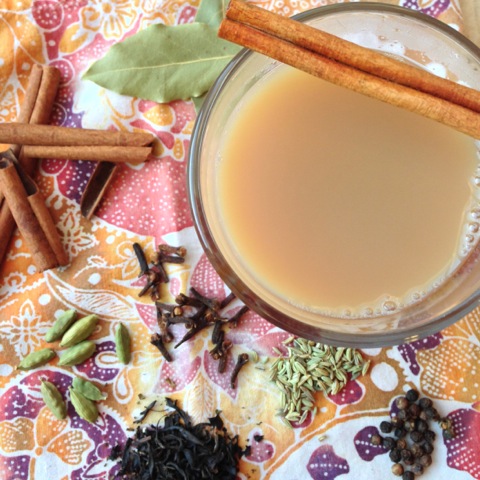Chai is steeped in a rich history. The name “chai” is actually the Hindi word for “tea”, which was derived from “cha”, the Chinese word for “tea”. In this case, the Hindi term chai means a mix of spices steeped into a tea-like beverage. Recipes for chai vary across continents, cultures, towns and families. But the traditional ingredients of a spiced tea blend usually include black tea mixed with strong spices, like cinnamon, cardamom, cloves, ginger and black peppercorns. The spiced tea mixture is typically brewed strong with milk and sweetened with sugar or honey. However, the milky sweet tea treat we order in coffee and tea shops today has very little in common with the origins of Indian chai.

Chai origins
Legend has it that the origin of chai dates back more than 5,000 years, when a king in what is now India ordered a healing spiced beverage be created for use in Ayurveda, a traditional medicinal practice in which herbs and spices are used for healing. The heat from ginger and black pepper was believed to stimulate digestion; the antiseptic properties in cloves were thought to help relieve pain; cardamom was used as a mood elevator; cinnamon supported circulation and respiratory function; and star anise was known to freshen the breath.
As the healing beverage spread across India a wide variety of spices were used to prepare the drink, depending on the region of the continent or even the neighborhood where the beverage was being made.
Believe it or not, original versions of “masala chai”, or “spiced tea”, contained no actual Camellia sinensis tea leaves. Milk and sugar were also later additions to the famous drink. The addition of black tea leaves, milk and sugar were popularized thousands of years later (in the mid-1800s) when the Camellia sinensis assamica tea plant variety was discovered in India and cultivated by the British, who ruled continent at the time and had an insatiable desire for strong black tea with milk and sugar.
Components of chai
Since traditional chai beverages can vary from town-to-town and family-to-family, there is no one recipe that defines chai. But the beverage typically consists of these ingredient categories:
 Tea: The Assam and Darjeeling black teas native to India are most popular to use as a chai base. But you’ll also find chai made with various types of green teas, the South American herb yerba mate or the South African herb red rooibos. You may also find completely herbal blends made only from spices and containing no tea leaves.
Tea: The Assam and Darjeeling black teas native to India are most popular to use as a chai base. But you’ll also find chai made with various types of green teas, the South American herb yerba mate or the South African herb red rooibos. You may also find completely herbal blends made only from spices and containing no tea leaves.
![]() Sweetener: White sugar, brown sugar and honey are typical chai sweeteners, but other sugars, like demerara, turbinado or coconut, may also be used. Jaggery, an unrefined cane sugar, is a popular sweetener used in parts of India.
Sweetener: White sugar, brown sugar and honey are typical chai sweeteners, but other sugars, like demerara, turbinado or coconut, may also be used. Jaggery, an unrefined cane sugar, is a popular sweetener used in parts of India.
![]() Milk: Indian chai is often made with buffalo milk. But the more Western version that we are used to is typically made with cow’s milk or dairy alternatives, like soy, almond, rice and coconut milks. You may also find yak or goat milk in other chai beverages around the world. Some recipes will have you steep a strong chai in water and then dilute it with milk. Other recipes have you simmer the chai spices in a mixture of water and milk or in all milk.
Milk: Indian chai is often made with buffalo milk. But the more Western version that we are used to is typically made with cow’s milk or dairy alternatives, like soy, almond, rice and coconut milks. You may also find yak or goat milk in other chai beverages around the world. Some recipes will have you steep a strong chai in water and then dilute it with milk. Other recipes have you simmer the chai spices in a mixture of water and milk or in all milk.
 Spices: The spices, or “masala”, used in chai will vary by region, climate and cultural preference. Traditionally, cardamom, ginger, cloves, cinnamon and black peppercorns were dominant chai spices and all readily available in India. Vanilla, nutmeg, mace, star anise or fennel may also be seen in some traditional recipes. As chai moved west, bay leaf, allspice, cacao or saffron became popular additions. Coriander and cumin may also show up in some recipes.
Spices: The spices, or “masala”, used in chai will vary by region, climate and cultural preference. Traditionally, cardamom, ginger, cloves, cinnamon and black peppercorns were dominant chai spices and all readily available in India. Vanilla, nutmeg, mace, star anise or fennel may also be seen in some traditional recipes. As chai moved west, bay leaf, allspice, cacao or saffron became popular additions. Coriander and cumin may also show up in some recipes.
Tasting chai
The huge variation of chai recipes means the beverage can take on many different flavor directions depending on the ingredients used. Chai that’s heavy on the ginger and black peppercorns can leave a fire-y bite. Others containing more vanilla, cinnamon or nutmeg may leave behind a sweeter note. Those with saffron or cacao may impart some earthy bitterness. And those using fennel or cumin may have a more savory note.
As a nod to Teatulia®’s tea garden origins on the subcontinent of India, our Teatulia Chai Tea was created with the more classic, original Indian chai flavors in mind. With a blend of black tea, ginger, cloves, cardamom and cinnamon, our chai is a beautiful balance of smooth and spicy. The bold spiciness of ginger and strong sweetness of clove shine through, but the spices don’t overshadow our full-bodied black tea leaves. Our chai is just as lovely steeped in water alone as it is with the addition of your favorite milk or sugar.

Caffeine content in chai
Teatulia Chai Tea contains black tea and so is similar in caffeine content to Teatulia Black Tea, which contains about half the caffeine than a cup of coffee. Ultimately, though, the caffeine content in any chai will vary depending on the amount of Camellia sinensis tea leaves the blend contains, where that tea plant was cultivated and how it was processed, and the way the chai was ultimately brewed for your cup.
Preparing chai
Since chai blends may contain different tea bases and different teas can have varying ideal brewing temperatures and steeping times, always ask your tea vendor for specific brewing instructions for the chai you purchased. Here are some general chai brewing tips to keep in mind:
- Chai can be steeped in water alone, a mixture of water and milk, or in milk alone, depending on your preference. (You never want to truly boil milk, though, or you could scald or burn it, leaving an off flavor.)
- If your chai came with specific recommendations for brewing, use those. But using about 2 grams of loose leaf chai blend per 8 oz. cup of water/milk is a safe bet.
- Always start with fresh, pure, cold filtered water when brewing tea. Spring water is the best. And cover your tea while it steeps to keep all the heat in the steeping vessel.
- Here is one classic chai steeping method: Steep your chai blend in one quarter to one half boiled water for up to 5 minutes (for chai with black or green tea leaves) or up to 15 minutes (for an herbal chai). Meanwhile, heat desired amount of milk to just barely a boil. Stir hot milk and desired sweetener into the water-steeped chai mixture. Strain and enjoy.
- Just as with straight black tea or green teas, you don’t want to oversteep a chai blend that contain tea or it may release some bitterness and astringency from the tea leaves. Taste your chai after the recommended steeping time and then decide if you’d like it to steep a little longer.
- If your chai contains black tea, it can be brewed a bit longer and in slightly hotter water temperatures than chai that contains green tea. Generally, this is somewhere between 200 and 212 degrees for 3 to 5 minutes. If your chai has a green tea base, it should be steeped at a lower temperature, somewhere around 170 to 190 degrees for 3 to 5 minutes. (If you don’t have an electric kettle with temperature control, just remember that at sea level water simmers at 190 degrees and boils at 212 degrees. The boiling temperature drops about a degree for every 1,000 feet in altitude increase.)
Buying and storing chai
A chai blend, just like any other tea blend, won’t really go “bad”, but it can get stale. To ensure you’re getting the freshest chai, buy it from a reputable company that can tell you when and how the chai was processed and packaged. Chai tea blends can stay fresh for up to a year with these storage tips in mind:
- Always store tea in a cool, dark place.
- Keep your tea away from heat, light, oxygen and moisture, and never store tea in the refrigerator.
- Tea will last longer if stored in an opaque, airtight container.
- Don’t let tea share the pantry with items like coffee and spices that can leach their flavor into the tea leaves.
For more information about how to best care for your tea, visit our How to Store Tea page.
Learn more about how tea is made.
Learn more about our single garden direct organic tea.

